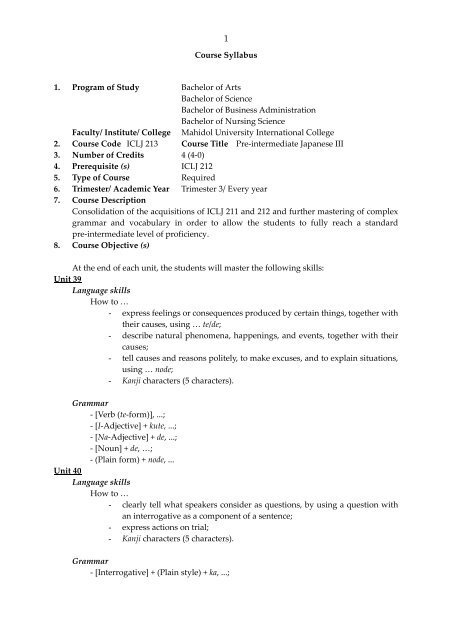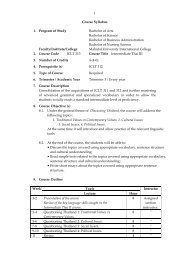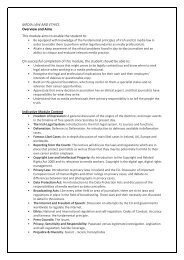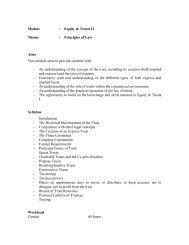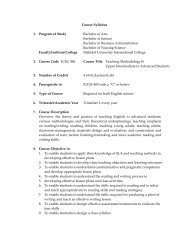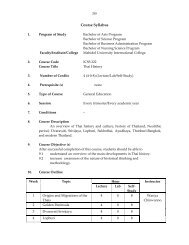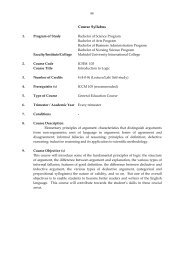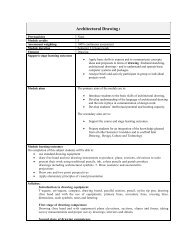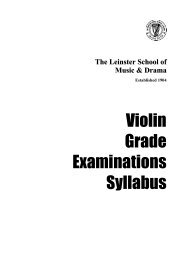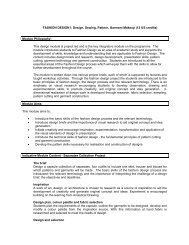ICLJ 213 Pre-intermediate Japanese III - KEI
ICLJ 213 Pre-intermediate Japanese III - KEI
ICLJ 213 Pre-intermediate Japanese III - KEI
You also want an ePaper? Increase the reach of your titles
YUMPU automatically turns print PDFs into web optimized ePapers that Google loves.
1<br />
Course Syllabus<br />
1. Program of Study Bachelor of Arts<br />
Bachelor of Science<br />
Bachelor of Business Administration<br />
Bachelor of Nursing Science<br />
Faculty/ Institute/ College Mahidol University International College<br />
2. Course Code <strong>ICLJ</strong> <strong>213</strong> Course Title <strong>Pre</strong>‐<strong>intermediate</strong> <strong>Japanese</strong> <strong>III</strong><br />
3. Number of Credits 4 (4‐0)<br />
4. <strong>Pre</strong>requisite (s) <strong>ICLJ</strong> 212<br />
5. Type of Course Required<br />
6. Trimester/ Academic Year Trimester 3/ Every year<br />
7. Course Description<br />
Consolidation of the acquisitions of <strong>ICLJ</strong> 211 and 212 and further mastering of complex<br />
grammar and vocabulary in order to allow the students to fully reach a standard<br />
pre‐<strong>intermediate</strong> level of proficiency.<br />
8. Course Objective (s)<br />
At the end of each unit, the students will master the following skills:<br />
Unit 39<br />
Language skills<br />
How to …<br />
- express feelings or consequences produced by certain things, together with<br />
their causes, using … te/de;<br />
- describe natural phenomena, happenings, and events, together with their<br />
causes;<br />
- tell causes and reasons politely, to make excuses, and to explain situations,<br />
using … node;<br />
- Kanji characters (5 characters).<br />
Grammar<br />
‐ [Verb (te‐form)], ...;<br />
‐ [I‐Adjective] + kute, ...;<br />
‐ [Na‐Adjective] + de, ...;<br />
‐ [Noun] + de, …;<br />
‐ (Plain form) + node, ...<br />
Unit 40<br />
Language skills<br />
How to …<br />
- clearly tell what speakers consider as questions, by using a question with<br />
an interrogative as a component of a sentence;<br />
- express actions on trial;<br />
- Kanji characters (5 characters).<br />
Grammar<br />
‐ [Interrogative] + (Plain style) + ka, ...;
2<br />
‐ (Plain form) + ka doka, ...;<br />
‐ [Verb (te‐form)] + mimasu.<br />
Unit 41<br />
Language skills<br />
How to …<br />
- use appropriate expressions for giving and receiving of things and actions,<br />
depending on the relationship between the giver and the receiver, in terms<br />
of social status;<br />
- make requests politely;<br />
- Kanji characters (5 characters).<br />
Grammar<br />
‐ Verbs: … o itadaki masu/ kudasai masu/ yari masu;<br />
‐ [Verb (te‐form)] + kudasai masen ka.<br />
Unit 42<br />
Language skills<br />
How to …<br />
‐ tell a purpose, using … tame ni;<br />
‐ tell usage, evaluation, necessary time, and expense, etc., using … (no) ni;<br />
‐ Kanji characters (5 characters).<br />
Grammar<br />
‐ [Verb (dictionary form)] + tame ni, …;<br />
‐ [Noun] + no tame ni, …;<br />
‐ [Verb (dictionary form)] + no ni, …;<br />
‐ [Noun] + ni, …;<br />
‐ [Quantifier] + wa, …;<br />
‐ [Quantifier] + mo, …<br />
Unit 43<br />
Language skills<br />
How to …<br />
- state a supposition based on the appearance of a thing, person, scene, etc,<br />
using … so desu;<br />
- express that someone is coming back to the original place after finishing an<br />
intended action, using … te kimasu;<br />
- Kanji characters (5 characters).<br />
Grammar<br />
‐ [Verb (masu‐form)] + so desu;<br />
‐ [Adjective] + so desu;<br />
‐ [Verb (te‐form)] + kimasu.<br />
Unit 44<br />
Language skills<br />
How to …<br />
- express that the degree of an action or a state is excessive, usually with<br />
reference to undesirable states, using … sugi masu;<br />
- describe the easiness or difficulty in handling or doing something, using<br />
…ysui/ … ni kui desu;
- use adjectives and nouns, with … ku/ … ni, as adverbs;<br />
- Kanji characters (5 characters).<br />
3<br />
Grammar<br />
‐ [Verb (masu‐form)] + sugi masu;<br />
‐ [Adjective] + sugi masu;<br />
‐ [Verb (masu‐form)] + yasui desu;<br />
‐ [Verb (masu‐form)] + nikui desu;<br />
‐ [I‐Adjective] + ku shimasu;<br />
‐ [Na‐Adjective] + ni shimasu;<br />
‐ [Noun] + ni shimasu;<br />
‐ [I‐Adjective] + ku + [Verb];<br />
‐ [Na‐Adjective] + ni + [Verb].<br />
Unit 45<br />
Language skills<br />
How to …<br />
- express how to cope with a situation or its consequence under a<br />
hypothetical situation, using … baai wa;<br />
- express speaker’s feelings of surprise, disappointment, or dissatisfaction<br />
when an expected consequence doesn’t follow, using … no ni;<br />
- Kanji characters (5 characters).<br />
Grammar<br />
‐ [Verb (dictionary form)] + baai wa, …;<br />
‐ [Verb (ta‐form)] + baai wa, …;<br />
‐ [Verb (nai‐form)] + baai wa, …;<br />
‐ [I‐Adjective] + baai wa, …;<br />
‐ [Na‐Adjective] + na baai wa, …;<br />
‐ [Noun] + no baai wa, …;<br />
‐ (Plain form) + no ni, …<br />
Unit 46<br />
Language skills<br />
How to …<br />
- tell an action, stressing a certain point in time during the course of the<br />
action (i.e., an action about to begin/ an action now in progress/ an action<br />
just completed), using … tokoro desu;<br />
- express the speaker’s feeling that not much time has passed since a certain<br />
action or event occurred, using … ta bakari desu;<br />
- express that the speaker is convinced and certain of what he/she states,<br />
using … hazu desu;<br />
- Kanji characters (5 characters).<br />
Grammar<br />
‐ [Verb (dictionary form)] + tokoro desu;<br />
‐ [Verb (te‐form)] + iru tokoro desu;<br />
‐ [Verb (ta‐form)] + tokoro desu;<br />
‐ [Verb (ta‐form)] + bakari desu;
‐ [Verb (dictionary form)] + hazu desu;<br />
‐ [Verb (nai‐form)] + nai hazu desu;<br />
‐ [I‐Adjective] + hazu desu;<br />
‐ [Na‐Adjective] + na hazu desu;<br />
‐ [Noun] + no hazu desu.<br />
9. Course Outline:<br />
4<br />
Week<br />
Topic<br />
Lecture<br />
Hour<br />
Instructor<br />
1 <strong>Pre</strong>sentation of the course.<br />
Unit 39 (Part 1).<br />
4 Assigned section<br />
instructor.<br />
2 Unit 39 (Part 2).<br />
4 Assigned section<br />
Unit 40 (Part 1).<br />
instructor.<br />
3 Unit 40 (Part 2).<br />
4<br />
Review.<br />
4 Unit 41. 4<br />
5 Unit 42. 4<br />
6 Review.<br />
Mid Term Examination.<br />
2<br />
2<br />
7 Unit 43. 4<br />
8 Unit 44. 4<br />
9 Review.<br />
4<br />
Unit 45 (Part 1).<br />
10 Unit 45 (Part 2).<br />
4<br />
Unit 46 (Part 1).<br />
11 Unit 46 (Part 2).<br />
Review.<br />
4<br />
Total 44<br />
NB. The coordinator reserves the right to change topics when appropriate.<br />
10. Teaching Method (s)<br />
Lecture, practical exercises, activities.<br />
11. Teaching Media<br />
Textbook, handouts, transparencies, audio cassette tape recorder, VCR.<br />
12. Measurement and evaluation of student achievement<br />
MUIC standard grading criteria: 90 % and above will have grade A.<br />
13. Course evaluation<br />
1. Quizzes 5 %;<br />
2. Mid Term Examination 45 %;<br />
3. Final Examination 50 %.
14. Reference (s)<br />
1. 3A Network (ed.), (1998) Minnna no Nihongo II: Main Textbook, 3A Network.<br />
2. ‐‐‐‐‐‐‐ (ed.), (1998), Minnna no Nihongo II: Translation & Grammatical Notes in<br />
English, 3A Network.<br />
3. Kono, T., et al., (1990) Basic Kanji Book Vol.1, Bonjinsha.<br />
4. Hirose, M., & Shoji, K., (1994), Nihongo Gakushu Tsukaiwake Jiten [Effective<br />
<strong>Japanese</strong> Usage Guide], Kodansha International.<br />
5. The Japan Foundation <strong>Japanese</strong> Language Institute, (1986), Basic <strong>Japanese</strong>‐English<br />
Dictionary [Kiso Nihongo Gakushu Jiten], Bonjinsha.<br />
6. Makino, S., & Tsuji, M., (1989), A Dictionary of Basic <strong>Japanese</strong> Grammar, Japan<br />
Times.<br />
7. Mynard, S. K., (1990), An Introduction to <strong>Japanese</strong> Grammar and Communication<br />
Strategies, Japan Times.<br />
8. Tanaka, Y., (1997), Japan As It Is, Gakushukenkyusha.<br />
15. Instructor (s)<br />
Mr Takayoshi Fujiwara<br />
Ms Orie Kasahara<br />
16. Course Coordinator<br />
Mr Takayoshi Fujiwara<br />
5


